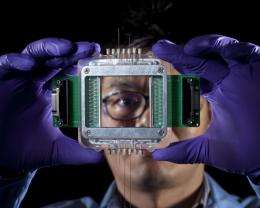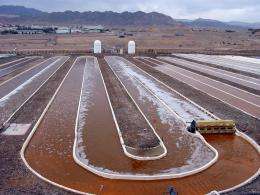Sandia using pathogen detection technology for understanding algal pond collapse

(PhysOrg.com) -- Armed with a pathogen detection technology honed through internal investments, as well as a recent $800K grant secured through the Department of Energy's Biomass Program, researchers at Sandia National Laboratories are tackling algal pond collapse, an issue that may be preventing some companies from producing the amount of algae it will take to make algal biofuels a cost-effective form of alternative energy.
Algae are widely viewed as a potential source of renewable fuel, but the technology to mass-produce fuel-grade algae is still in the early stages. A major roadblock is the inability to produce large amounts of the greenish, chlorophyll-containing organisms.
Algae are commonly grown in raceway ponds, large, shallow, artificial ponds that serve as fields for algae crops. But when water is constantly re-used, mixed or blended (a common practice at multi-acre algae production facilities), the ponds are prone to attack by agents such as fungi, viruses or predators like zooplankton.
“The organisms fall into these ponds and can crash a pond overnight,” said Todd Lane, a molecular biologist and algae researcher at Sandia’s California site. “Many of the agents that are causing these pond crashes have not been identified, and you can’t develop countermeasures without understanding why something is happening.” Pond crashes, Lane said, are often characterized by a sudden emergence of infection followed by rapid loss of algal biomass.
Sandia’s winning DOE proposal, titled “Pond Crash Forensics,” will use pathogen detection and characterization technologies developed through the lab’s Rapid Threat Organism Recognition, or RapTOR, project. RapTOR was originally developed for homeland security purposes.
The RapTOR program seeks to solve the “unknown unknowns” problem - lethal agents that could be weaponized from ordinary viruses or disguised to look harmless - by developing a tool to rapidly characterize a biological organism with no pre-existing knowledge. Sandia’s researchers, Lane says, are taking advantage of rapidly evolving molecular biology technology and the advent of ultra-high-throughput DNA sequencing in order to re-engineer time-intensive benchtop methods to be faster, easier and automated.
That same tool, he says, can be used to quantify the “unknown unknowns” at the root of pond crashes. Sandia’s researchers will obtain samples of water from “freshly” crashed ponds and unaffected ponds grown in parallel at the same facility under similar conditions. They’ll focus on common production strains such as Nannochloropsis and Neochloris in primarily open pond architectures.
Sandia’s technical approach will combine modern methods of metagenomic analysis, advanced imaging and field microbiology / virology to identify, characterize and, when possible, isolate the agent causing a pond crash.

The project will also employ Sandia’s unique capabilities in hyperspectral fluorescence imaging to characterize stress-induced fluctuations in algal photosynthetic pigments in both experimental and field systems. The project’s first year will focus on the identification and isolation of those agents causing pond crashes, while during the second year of the project researchers will create pond crashes “on demand” for laboratory analysis and experimentation leading to countermeasure development.
According to Lane, the goal is to develop a method for rapid characterization of the responsible predatory agents and either a device or service for companies that will help make their algae ponds more productive.
“For the commercial sector involved in producing algae, this will save money since those companies will maintain better control over their ponds and experience less impact on their production schedules,” Lane said. “We feel that we’re in a good position to address this particular roadblock. It’s a good niche for Sandia, and something that allows us to provide a service that will be of great benefit to the algal biofuel industry that will in turn greatly benefit the nation.”
Provided by Sandia National Laboratories



















